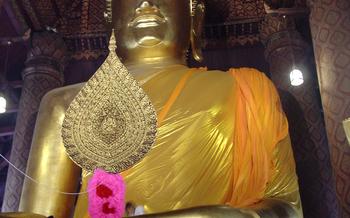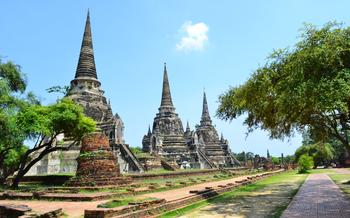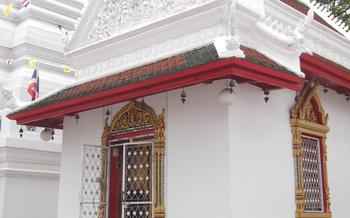
Wat Tham Heo Sin Chai
- A Temple in a Cave
- Exploring the Cave
- The Buddha Images
- Ancient Murals and Paintings
- Meditation and Spiritual Retreats
- Local Cuisine and Delicacies:
- Festivals and Events:
- Accommodation and Amenities
- History and Legends
- Responsible Tourism
- Photography and Videography
- Local Guides and Tours
- Insider Tip: Unveiling the Secret Chamber
A Temple in a Cave
Nestled within the picturesque landscapes of Ubon Ratchathani, Thailand, lies Wat Tham Heo Sin Chai, an ancient cave temple that exudes a profound spiritual aura. Its unique location inside a natural limestone cave sets it apart from other temples in the region, inviting visitors to delve into a realm of tranquility and spirituality. The temple's history is shrouded in mystery, with local legends tracing its origins back to the 16th century when a revered monk, Luang Pho Heo, sought refuge in the cave during a tumultuous period. Over time, the cave became a sanctuary for meditation and spiritual practices, attracting devotees and pilgrims from near and far.
As you approach the temple, the serene atmosphere envelops you, inviting you to leave behind the worldly distractions and enter a sacred space. The cave's entrance is adorned with intricate carvings and sculptures, hinting at the wonders that lie within. Stepping inside, you are greeted by the dim and flickering light of candles, casting an ethereal glow on the cave walls. The air is thick with the scent of incense, further enhancing the sense of reverence and spirituality.
Exploring the Cave
Wat Tham Heo Sin Chai is nestled amidst a stunning natural landscape, and its cave setting adds to its allure. To access the cave, visitors must pass through a narrow entrance, which leads to a series of chambers and tunnels. The cave's interior is adorned with intricate stalactites and stalagmites, creating a mesmerizing spectacle. Natural light filters through the cave's openings, illuminating the formations and casting a warm glow on the cave walls.
The cave is home to a diverse array of wildlife, including bats, spiders, and insects. Visitors may encounter these creatures during their exploration, adding to the sense of adventure. It's essential to be respectful of the wildlife and avoid disturbing their natural habitat.
Exploring the cave requires caution and proper footwear. The ground can be uneven and slippery, so sturdy shoes are recommended. Visitors should also bring a flashlight or headlamp to navigate the darker areas of the cave. It's important to stay on designated paths and avoid touching or damaging the cave formations.
The Buddha Images
Wat Tham Heo Sin Chai houses an awe-inspiring collection of Buddha images, each radiating a distinct aura of serenity and spirituality. These majestic figures, carved from various materials such as gold, bronze, and wood, exhibit a diverse range of styles and sizes. Some stand tall, exuding an air of grandeur, while others sit in serene contemplation, inviting visitors to find solace in their presence.
The Buddha images at Wat Tham Heo Sin Chai are not merely decorative pieces; they hold deep religious significance. Each posture, mudra (hand gesture), and facial expression conveys a specific meaning or aspect of the Buddha's teachings. Visitors can find representations of the Buddha in various mudras, including the Abhaya mudra (gesture of fearlessness) and the Dhammachakra mudra (gesture of teaching the wheel of dharma).
These Buddha images are not just objects of worship; they are believed to possess a spiritual energy that can inspire and uplift devotees. Many visitors come to the temple to pay homage to these sacred figures, seeking blessings, guidance, and inner peace. The temple's serene atmosphere, coupled with the presence of these revered images, creates a powerful aura that invites contemplation and spiritual reflection.
Ancient Murals and Paintings
Wat Tham Heo Sin Chai is renowned for its exquisite murals and paintings that adorn the walls of the cave temple. These artworks possess immense historical and cultural significance, dating back centuries. Created using traditional techniques, these murals and paintings depict scenes from Buddhist mythology, local folklore, and the temple's own history.
The murals showcase a vibrant array of colors, intricate details, and expressive figures. The artists skillfully employed natural pigments and minerals to create these masterpieces, resulting in a harmonious blend of colors that have withstood the test of time. Each mural tells a unique story, providing a glimpse into the beliefs, customs, and traditions of the local community.
Visitors can admire the murals depicting the life of Buddha, including his birth, enlightenment, and teachings. Other murals depict scenes from Thai legends and folktales, offering insights into the rich cultural heritage of the region. The paintings also showcase the natural beauty of the surrounding landscapes, with lush forests, flowing rivers, and majestic mountains depicted in intricate detail.
Exploring these ancient murals and paintings is a journey through time. They offer a glimpse into the past, allowing visitors to connect with the beliefs, values, and artistic traditions of the people who created them. The murals and paintings at Wat Tham Heo Sin Chai serve as a testament to the enduring power of art and its ability to transcend time and culture.
Meditation and Spiritual Retreats
Wat Tham Heo Sin Chai is renowned as a sanctuary for meditation and spiritual retreats. Its serene and tranquil environment, nestled within the natural beauty of the cave, provides an ideal setting for self-reflection and inner peace. The temple offers meditation programs and retreats throughout the year, catering to individuals seeking spiritual growth and rejuvenation.
During my visit, I had the opportunity to participate in a meditation session led by a local monk. The peaceful atmosphere of the cave and the gentle guidance of the monk allowed me to delve deep into my inner self. I experienced a sense of calm and tranquility that I had never felt before.
The temple also offers longer retreats, ranging from a few days to several weeks, for those seeking a more immersive spiritual experience. These retreats typically involve intensive meditation practices, yoga, and teachings on Buddhist philosophy.
Local Cuisine and Delicacies:
In the vicinity of Wat Tham Heo Sin Chai, visitors can indulge in the flavors of authentic Thai cuisine. Local restaurants and street stalls offer a variety of dishes that showcase the region's culinary traditions and use fresh, locally sourced ingredients.
One must-try delicacy is the Som Tum, a spicy green papaya salad with a tangy and refreshing flavor. Khao Pad Sapparot, or pineapple fried rice, is another popular dish, combining sweet and savory flavors with succulent shrimp and vegetables. For a taste of local street food, try the Sai Krok Isan, a grilled fermented sausage with a unique and flavorful taste.
Don't miss the opportunity to sample the region's signature dish, Tom Kha Gai, a coconut milk-based soup with tender chicken, mushrooms, and galangal. For a sweet treat, try the Khao Neeo Mamuang, or sticky rice with ripe mango, a classic Thai dessert that is both delicious and visually appealing.
When dining in Ubon Ratchathani, be sure to embrace the local culture and try some of the unique dishes and flavors that the region has to offer. Whether you prefer spicy, sour, or sweet, there's something for every palate to enjoy.
Festivals and Events:
Wat Tham Heo Sin Chai comes alive during various festivals and events throughout the year, offering visitors a chance to immerse themselves in the temple's vibrant religious and cultural traditions. One of the most significant events is the annual Bun Phra Wet festival, held in July, where locals make merit by offering food and other items to the temple monks. The festival features colorful processions, traditional music and dance performances, and a lively market selling local delicacies.
Another notable event is the Makha Puja festival, celebrated in February or March, which commemorates the day when the Buddha gave his first sermon to his disciples. During this festival, the temple hosts special meditation sessions, chanting ceremonies, and candlelight processions, creating a serene and spiritual atmosphere.
If you happen to visit Wat Tham Heo Sin Chai during these festivals, be prepared for a unique and unforgettable experience that showcases the temple's rich cultural and religious heritage.
Accommodation and Amenities
When planning your visit to Wat Tham Heo Sin Chai, finding comfortable and convenient accommodation is essential. Fortunately, there are several options available in the vicinity of the temple to suit different budgets and preferences.
For a truly immersive experience, consider staying at a local guesthouse or homestay. These accommodations offer a chance to interact with the friendly locals and gain insights into their way of life. Homestays often provide home-cooked meals, allowing you to sample authentic Thai cuisine and immerse yourself in the local culture.
If you prefer more modern amenities, several hotels and resorts are located within a short distance from the temple. These establishments offer a range of facilities, including comfortable rooms, swimming pools, and restaurants.
Regardless of your choice of accommodation, you'll find a variety of restaurants, shops, and other amenities in the area. Local markets offer fresh produce, snacks, and souvenirs, while restaurants serve everything from traditional Thai dishes to international cuisine.
To find the best accommodation deals, consider booking online or contacting local travel agents. They can provide recommendations and help you secure reservations. Remember to book in advance, especially during peak tourist seasons, to avoid disappointment.
History and Legends
Wat Tham Heo Sin Chai has a rich history and is steeped in local legends that add to its mystique. The temple is believed to have been founded in the 17th century by a group of Buddhist monks who sought refuge in the cave. According to legend, the monks were guided by a mysterious spirit who led them to the cave, which was then hidden by thick vegetation. The monks were so impressed by the beauty and serenity of the cave that they decided to build a temple there.
Over the years, Wat Tham Heo Sin Chai has become a popular pilgrimage site for Buddhists from all over Thailand. It is also a popular tourist destination due to its unique location inside a cave and its impressive collection of Buddha images. The temple is also associated with several local legends, one of which tells the story of a giant snake that once lived in the cave. The snake is said to have protected the temple from intruders and brought good fortune to the local people.
Responsible Tourism
When visiting Wat Tham Heo Sin Chai, it is essential to practice responsible tourism to preserve its sacredness and protect the environment. Show respect for local customs and traditions by dressing modestly and avoiding loud or disruptive behavior. Remember that the temple is an active place of worship, so be mindful of ongoing religious ceremonies and maintain a respectful silence.
To minimize environmental impact, reduce your plastic waste by bringing your own water bottle and avoiding single-use plastics. Support sustainable initiatives by choosing local restaurants and shops that prioritize eco-friendly practices. Embrace the opportunity to learn about and appreciate the local culture by engaging with the community in a respectful and meaningful way. Your responsible actions not only contribute to the preservation of this sacred site but also ensure a positive and memorable experience for everyone.
Photography and Videography
Capturing the beauty and spirituality of Wat Tham Heo Sin Chai through photography and videography is a wonderful way to preserve your memories and share them with others. However, it's important to be mindful of the temple's sacredness and follow proper etiquette when taking photos or videos.
Guidelines and Restrictions:
- Respectful Behavior: Avoid using flash photography or video lights, as they can be disruptive to other visitors and disrespectful to the temple's atmosphere.
- Privacy Concerns: Be considerate of other visitors' privacy. Avoid taking close-up photos or videos of people without their permission.
- Temple Interiors: When taking photos or videos inside the temple, be mindful of any signs or instructions regarding restrictions or prohibited areas.
Tips for Stunning Visuals:
- Natural Light: Utilize natural light whenever possible to capture the temple's intricate details and vibrant colors.
- Composition: Experiment with different angles and compositions to create visually appealing shots that showcase the temple's unique features.
- Silent Mode: Keep your camera or phone on silent mode to avoid disturbing the peaceful atmosphere of the temple.
By following these guidelines and tips, you can capture stunning visuals that respect the sacredness of Wat Tham Heo Sin Chai while preserving your memories of this extraordinary temple.
Local Guides and Tours
Enhancing your experience at Wat Tham Heo Sin Chai is the option of hiring local guides or joining organized tours. Knowledgeable guides can provide invaluable insights into the temple's history, religious significance, and local traditions. They can point out hidden details and share stories that bring the temple to life. Organized tours often include transportation, making it convenient for visitors who don't want to worry about logistics.
When choosing a guide or tour, it's important to do your research and find reputable operators. Look for guides who are licensed and knowledgeable about the temple. Organized tours should have clear itineraries and provide a safe and enjoyable experience.
I highly recommend booking a guided tour if you want to learn more about the temple's history and significance. It's an excellent way to make the most of your visit and gain a deeper understanding of this sacred site.
Insider Tip: Unveiling the Secret Chamber
Beyond the main chambers of Wat Tham Heo Sin Chai, there lies a hidden gem waiting to be discovered. Tucked away in a secluded corner of the cave, a secret chamber houses a collection of ancient artifacts and relics that provide a glimpse into the temple's rich history.
To access this hidden chamber, visitors must seek permission from the temple's abbot or a knowledgeable guide. Once granted access, they will be led through a narrow passageway that leads to a small, dimly lit chamber. Inside, they will find a treasure trove of ancient Buddha images, religious scriptures, and ceremonial objects that have been carefully preserved over the centuries.
The walls of the chamber are adorned with intricate murals depicting scenes from Buddhist mythology and local folklore. These artworks provide a vivid glimpse into the beliefs and traditions of the people who built and worshipped at this sacred site.
Exploring this secret chamber is a unique and enriching experience that allows visitors to connect with the temple's past and gain a deeper appreciation for its cultural and religious significance. It is a reminder that even in the most well-known and visited places, there are still hidden treasures waiting to be discovered by those who dare to explore beyond the surface.




